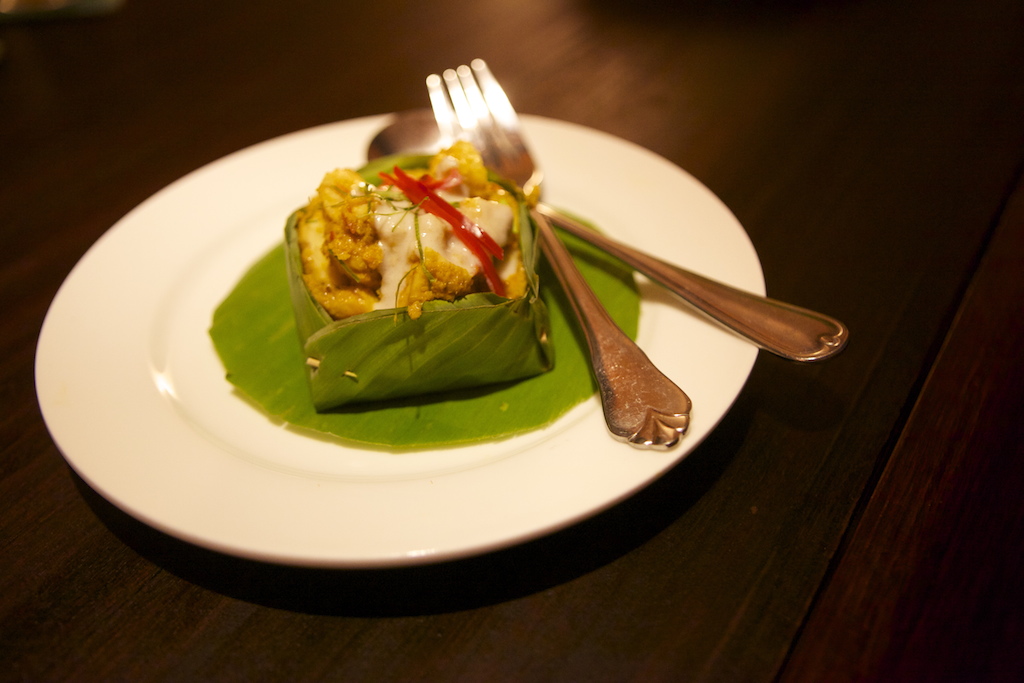The food: Fish Amok, Cooked and Served in Banana Leaf
Where to find it: Romdeng Restaurant, Phnom Penh, Cambodia
-:-
Cambodia shrouds itself in mystery. Their people don’t do it on purpose; it’s not like they’re hiding from the world—far from it1. Lost between the spice jungles of Thailand and the toiling, yet tranquil, rice paddies of Vietnam, resides a country still finding itself. Still maturing. Still repairing from the country-wide butcher shop that was the Khmer Rouge regime and their war—nay, genocide—against its very own people. The slaughter severed a country from its past—its identity.
Yet, as with all great traditions, the traditional Cambodian fish amok persevered.
When you enjoy a dish of fish amok, your taste buds teeter on a tightrope of Thai spice and perennial Cambodian flavors. Yet when diners explore this dish further, they’ll discover the tradition that reminds you it’s strictly Cambodian.
All tastes of Cambodia coalesce to create fish amok. A daily fisherman hauls in his catch of blue-eye fish from the Mekong River at the base of a stone temple gopura. A Cambodian grandmother delivers a sack of spices: galangal, turmeric, lemongrass, chillies. A farmer donates his banana leaves. The Cambodian people have made this dish for years. Cambodia may look towards its more well-known neighbors like Thailand for guidance, but the chefs of fish amok know tradition is tradition. They know the drill, and they’ve perfected the taste of fish amok for years.
These far-reaching ingredients of Cambodia whip together into a spicy fish curry that shocks the senses like Angkor Wat at Sunrise. At the same time, the coconut milk and banana leaf wrappings soothe the tastebuds. With each spoonful of tender fish and curry, a benign sting purrs on your palate.
Only a country that has healed the sting of genocide can take something so harsh as Cambodian chillies and tame it to create a smooth curry that begs to be drunk like milk2. That’s tradition rediscovered and carrying on. That’s Cambodia.
-:-
Fish Amok Recipe (Serves 4)
- 2 dried red chillies (see note), soaked in boiling water, drained, chopped
- 3 garlic cloves, chopped
- 1 tablespoon grated fresh turmeric (see note)
- 2 tablespoons grated galangal (see note)
- 2 lemongrass stems (inner core only), grated
- 2 eschalots, chopped
- Finely grated zest of 1 lime
- 1 tablespoon shrimp paste (see note)
- 1/4 cup (65g) grated palm sugar (see note)
- 6 kaffir lime leaves, finely shredded (see note)
- 400ml coconut milk
- 400g skinless blue-eye fillet, cut into 3-4cm pieces
- 12 green prawns, peeled (tails intact), deveined
- 2 banana leaves (see note)
- 1 long red chilli, thinly sliced
- Steamed rice, to serve
1) Add together the chilli, garlic, turmeric, galangal, lemongrass, eschalot, lime zest, shrimp paste, palm sugar, half the kaffir lime leaves and 2 teaspoons salt in a bowl and pound together to a fine paste.
2) Pour paste into a pan over medium heat. Cook and stir for 3-4 mins until fragrant. Add the coconut milk (reserving 2 tablespoons for serving) and bring to simmer. Remove from stove and transfer to a bowl allowing the paste to cool slightly. Add the seafood and toss to mix and combine.
3) Cut each banana leaf into two 25cm x 15cm rectangles. Carefully wave both sides of each leaf over a medium-high flame, then set aside (the heat from the flame will soften the leaves, making them more pliable). Lay each banana leaf out, divide the seafood among the leaves and fold in the ends, securing with toothpicks to form 4 small trays. Top with remaining marinade and sprinkle with remaining kaffir lime leaves and half the sliced chilli. Place in a steamer over medium-high heat and cook for 15 minutes or until the fish is tender and cooked through.
4) Place the seafood parcels on serving plates. Remove toothpicks, drizzle with remaining 2 tablespoons coconut milk and scatter with remaining sliced chilli. Serve with rice.
-:-
1 Right now their tourism industry is marketing like crazy.
2 In fact, when you eat amok, drink all of the curry straight from the banana leaf container. It will transport you, ever so briefly, to a simpler time and place of monkeys swinging on trees and monks pacing temples.
3 JOB OPPORTUNITY: The above picture comes straight out of another scene from my travel & food web series I’m filming in Asia. Longa Productions is currently seeking (documentary/trailer) editors for post-production. If you’re interested in learning more, then please send an email to [email protected].
4 Fish Amok Recipe by Taste.com.au

